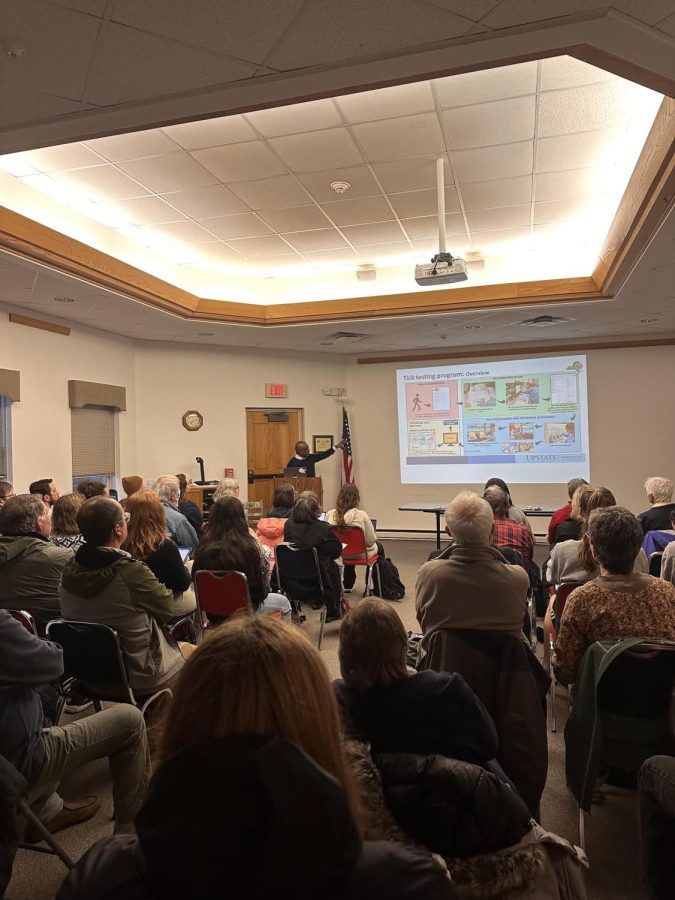Tick Talk: The Status and Public Health Implications of Tick Borne Diseases
The Upstate Institute at Colgate University hosted a panel at the Hamilton Public Library to discuss tick-borne diseases — including their prevalence, transmission, detection, treatment, and prevention — and how they affect the greater Madison County community. At the Apr. 5 event, multiple speakers were presented, including Colgate University students, faculty, and health science professionals.
The panel showcased data collected by Catherine Cardelus, Upstate Institute director, and Colgate professor of biology and environmental studies. Saravanan Thangamani, director of the Thangamani Lab at SUNY Center for Vector-Borne Disease at Upstate Medical, also presented information about tick testing and the prevalence of various detected diseases, as well as resources for tracking tick diseases in the area.
“We take all [the data the lab collects from submitted ticks] and then make a dashboard as well, that is we call it ‘Tick Map’ […] that is available for anyone to see,” Thangamani said. “Thus far we have tested 28,000 tick-human encounters.”
After their presentations, Madison County Public Health Educator Dhaani Mahayan spoke about how tick-borne diseases are a public health problem.
Senior Hallie Koslowski, a biology major and global public and environmental health and sociology double minor, presented her study on community knowledge of identifying and preventing tick-borne diseases. She highlighted that many people do not take enough precautions with ticks, and are unaware of the full spectrum of viral and bacterial illnesses they carry.
“100% of respondents knew what Lyme disease was, which is great, however when it came to the other diseases this dropped significantly,” Koslowski said.
Koslowski’s study aligned with the presenters’ focus on tick prevention. Cardelus shared data from a study on deer populations and culling. Deer are a major tick carrier, and both Koslowski and Mahayan’s speeches focused on increasing public knowledge of tick carriers and preventative measures. Much of the work Thangamani does is related to testing ticks for various pathogens, and compiling the data his lab collects so it is accessible to the public.
Senior Kiara Hills, who was involved in Koslowski’s study, was surprised by Koslowski’s findings.
“I was a part of [Koslowski’s] research tutorial on the project,” Hills said. “I was super interested by the fact that people aren’t acting to protect themselves as much at home. I think it might show a lack of understanding of how people are at risk at all times outside.”
After attending the panel, Hills was struck by what she learned from the other presenters, especially about the prevalence of ticks in New York.
“I was also surprised by the amount of other diseases [ticks] carry. I didn’t realize the scale of everything,” Hills said.
Senior Allison Yetter also attended the talk to hear Koslowski’s presentation and had a similar takeaway to Hill’s in that she hadn’t previously understood the full extent of the problem.
“The aspect of the talk that stood out to me the most was how many residents of Hamilton have been affected by tick bites,” Yetter said.
The community members who attended the talk were engaged and curious during the Q&A session, with some even bringing ticks they’d recently found as well as their favorite tick-removal tools. It was evident that ticks — and the pathogens they carry — are a serious and widespread concern among Madison County residents.
“Most of the audience appeared to be people from town rather than students, so it seemed to be a big problem for people who live here,” Yetter added. “One of my professors has mentioned that Lyme disease has drastically changed her quality of life, and I had no idea it was so common in this part of the country. I hope that there is more research and preventative measures taken to reduce the impacts of ticks on people in the area.”

LJ Coady is a junior from Houston, TX concentrating in political science with minors in history and religion. She has previously served as a writer for...







